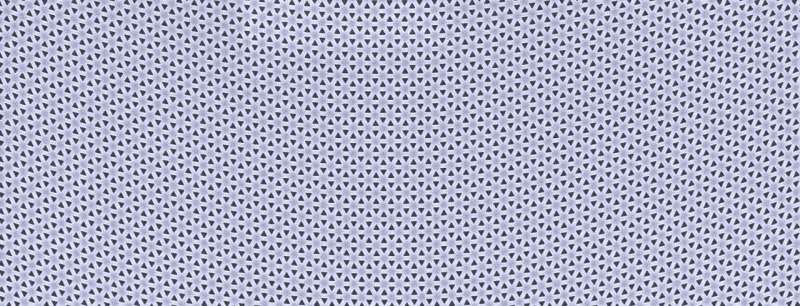Electron microscope image of a photonic crystal. The diameter of the triangular hole is 300 nanometers. The curvature of the crystal array prevents the movement of light waves in the crystal. Image source: AMOLF
AMOLF researchers, in collaboration with Delft University of Technology, have succeeded in stopping light waves by deforming a two-dimensional photonic crystal that contains them. The researchers showed that even small deformations can have a significant impact on photons in the crystal. This is similar to the effect of magnetic fields on electrons.
Ewold Verhagen, group leader at AMOLF, said: “This principle provides a new way to slow down the speed of the light field and thereby enhance its intensity. Realizing this on a wafer is particularly important for many applications.”
The researchers published their findings in the journal Nature Photonics. Meanwhile, a Penn State research team published an article in the same journal describing how they demonstrated the same effect independently of the Dutch team.
Manipulating light flow in materials at small scales could facilitate the development of nanophotonic chips. For electrons, this manipulation can be achieved through magnetic fields; the Lorentz force guides the electron’s motion. However, this is not possible with photons because they have no electric charge.
Researchers in the AMOLF Photon Forces Group are looking for technologies and materials that would allow them to exert forces on photons similar to the effects of magnetic fields.
electronic
“We look for inspiration in the way electrons behave in materials. In conductors, electrons can in principle move freely, but an external magnetic field prevents this. The circular motion caused by the magnetic field stops conduction, so electrons can move only if they have very They exist in materials only when they have a specific amount of energy.
“But in the two-dimensional material graphene – which consists of a single layer of carbon atoms arranged in a crystal – these Landau levels may also be caused by mechanisms different from magnetic fields. Generally speaking, graphene is a A good conductor of electrons, but this changes when the crystal array deforms, such as stretching it like an elastomer.
“This mechanical deformation stops conduction; the material becomes an insulator, so the electrons are trapped at the Landau level. Therefore, even in the absence of magnets, deformation of graphene has a similar effect to the electrons in the material as a magnetic field. We asked if A similar approach works for photons, and we can do it ourselves.
Photonic crystals
In collaboration with Kobus Kuipers at TU Delft, Verhagen’s team did demonstrate similar light effects in photonic crystals.
“Photonic crystals usually consist of a regular two-dimensional pattern of holes in a silicon layer. Light can move freely in this material, just like electrons in graphene,” said Rene Balchi, the first author who successfully defended his doctoral thesis. René Barczyk said. 2023 Paper on this Topic.
At the Landau level, the light waves no longer move; instead of flowing through the crystal, they stand still. The researchers successfully demonstrated this, showing that deformation of the crystal array affects photons similarly to the effect of magnetic fields on electrons.
“By studying the deformation patterns, we even managed to create various types of effective magnetic fields in a material,” Verhagen said. “As a result, photons can pass through some parts of the material but not others. So these insights are also Provides new ways to control light on a wafer.
Synchronous experiments
Verhagen and his team’s work was inspired by theoretical predictions from researchers at Penn State University and Columbia University. Verhagen recalls: “While we were making the first measurements, I happened to be talking to one of the authors of another study. When we found out that they were also looking for experimental evidence of this effect, we decided not to compete for the first one. One person.
Although some details of the methods differed, both teams were able to deform the two-dimensional photonic crystal to stop the light waves from moving and observe the Landau energy level.
“This brings the on-chip applications much closer,” Verhagen said. “If we could confine light to the nanometer scale and stop it, its intensity would be greatly enhanced. And not just in one location, but across the entire surface of the crystal. This concentration of light is very important in nanophotonic devices , as examples of developing efficient laser or quantum light sources.
More information:
Ren Barczyk et al., Observing Landau levels and chiral edge states in photonic crystals through synthetic strain-induced pseudomagnetic fields, Nature Photonics (2024). DOI: 10.1038/s41566-024-01412-3
citation: Light comes to rest in a deformed crystal (2024, April 24), Retrieved April 24, 2024, from https://phys.org/news/2024-04-deformed-crystal.html
This document is protected by copyright. No part may be reproduced without written permission except in the interests of fair dealing for private study or research purposes. Content is for reference only.
#Light #rest #deformed #crystal
Image Source : phys.org
